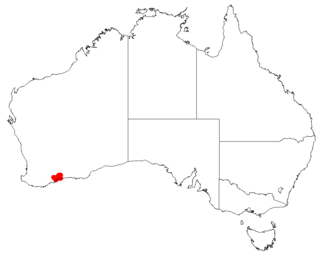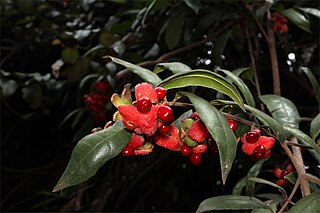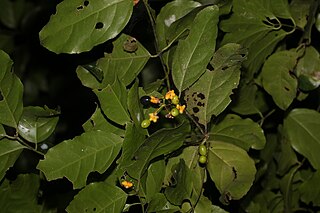
Dillwynia tenuifolia is a species of flowering plant in the family Fabaceae and is endemic to eastern New South Wales. It is an erect shrub with linear leaves, and orange-yellow and red flowers.

Wilkiea hugeliana, commonly known as veiny wilkiea, common wilkiea or tetra beech, is a species of flowering plant in the family Monimiaceae, and is endemic to eastern Australia. It is a tall shrub or small tree with egg-shaped, oblong to narrowly elliptic leaves, and male and female flowers on separate plants. Male flowers have 3 or 4 stamens and female flowers have 20 to 40 carpels, and the fruit is a blackish oval drupe with a yellow to orange receptacle.

Persoonia chamaepeuce, commonly known as the dwarf geebung or heathy geebung, is a plant in the family Proteaceae and is endemic to south-eastern Australia. It is a prostrate shrub with crowded, linear leaves and yellow flowers in the leaf axils.

Zanthoxylum nitidum, commonly known as shiny-leaf prickly-ash, is a species of flowering plant in the family Rutaceae. It is a woody climber with prickles on the branchlets, thick, cone-shaped spines on the trunk and older branches, pinnate leaves with five to nine leaflets, and panicles or racemes of white to pale yellow, male or female flowers in leaf axils and on the ends of branchlets.

Persoonia dillwynioides, commonly known as Fitzgerald persoonia, is a species of flowering plant in the family Proteaceae and is endemic to a restricted area in the south-west of Western Australia. It is an erect, spreading shrub with smooth bark, linear leaves and bright yellow flowers borne singly or in groups of up to four along a rachis up to 3 mm (0.12 in) long.

Persoonia trinervis is a species of flowering plant in the family Proteaceae and is endemic to the south-west of Western Australia. It is an erect, sometimes spreading shrub with densely hairy young branchlets, spatula-shaped or lance-shaped leaves with the narrower end towards the base, and densely hairy yellow flowers.

Persoonia sulcata is a plant in the family Proteaceae and is endemic to the south-west of Western Australia. It is a small, erect or low spreading shrub with narrow, linear leaves and cylindrical yellow flowers arranged singly or in groups of up to three in leaf axils. It grows in woodland or on rocky slopes and is found in several disjunct populations.
Persoonia hakeiformis is a species of flowering plant in the family Proteaceae and is endemic to the south-west of Western Australia. It is an erect or spreading to low-lying shrub with mostly smooth bark, linear leaves and bright yellow flowers borne in groups of up to sixty along a rachis up to 100 mm (3.9 in) long.

Zanthoxylum rhetsa, commonly known as Indian prickly ash, is a species of flowering plant in the family Rutaceae and occurs from India east to the Philippines and south to northern Australia. It is a deciduous shrub or tree with cone-shaped spines on the stems, pinnate leaves with between nine and twenty-three leaflets, panicles of white or yellowish, male and female flowers, followed by spherical red, brown or black follicles.

Leptospermum myrtifolium, commonly known as the myrtle tea-tree or grey tea-tree, is a species of shrub that is endemic to south eastern Australia. It has broad egg-shaped to elliptical leaves, white flowers usually borne singly on short side shoots, and fruit that remains on the plant until it dies.

Philotheca myoporoides subsp. myoporoides, commonly known as long-leaf wax flower, is a subspecies of flowering plant in the family Rutaceae and is endemic to south-eastern continental Australia. It is a shrub with oblong to elliptic or egg-shaped leaves and white or pink flowers arranged in groups of three to eight in leaf axils.

Pultenaea euchila, commonly known as orange pultenaea, is a species of flowering plant in the family Fabaceae and is endemic to eastern Australia. It is an erect shrub with glabrous foliage, narrow egg-shaped leaves with the narrower end towards the base, and orange-coloured flowers arranged singly or in small groups near the ends of branchlets.
Olearia chrysophylla is a species of flowering plant in the family Asteraceae and is endemic to eastern Australia. It is a shrub with scattered elliptic leaves, and white and yellow, daisy-like inflorescences.

Olearia quercifolia, commonly known as oak-leaved olearia, is a species of flowering plant in the family Asteraceae, and is endemic to the Blue Mountains in New South Wales. It is a shrub with elliptic to egg-shaped leaves with the narrower end towards the base, and white and yellow daisy flowers.

Wilkiea angustifolia is a species of flowering plant in the family Monimiaceae, and is endemic to Queensland. It is a dioecious shrub with elliptic leaves, male and female flowers on separate plants, male flowers with 4 stamens, female flowers with 8 to 20 carpels, and the fruit a purple to black drupe.
Wilkiea cordata is a species of flowering plant in the family Monimiaceae, and is endemic to north-east Queensland. It is a shrub or small tree with oblong leaves, male and female flowers on separate plants, male flowers with stamens in 2 pairs, female flowers with about 25 carpels, and the fruit is an oval drupe with a yellow receptacle with an orange tinge.

Palmeria racemosa is a species of flowering plant in the family Monimiaceae and is endemic to eastern Australia. It is a woody vine with elliptic to oblong leaves and male and female flowers borne on separate plants, male flowers usually with thirty to forty stamens and female flowers with about ten carpels. The fruit is green, splitting to form a pinkish receptacle with 3 to 7 black or red drupes.
Wilkiea hugeliana is a species of flowering plant in the family Monimiaceae, and is endemic to Cape York Peninsula in far northern Queensland. It is a shrub or small tree with elliptic, sometimes toothed leaves, and male and female flowers on separate plants. Male flowers usually have 4 pairs of stamens and female flowers have about 40 carpels, and the fruit is a glossy black drupe with enlarged orange receptacles.
Wilkiea kaarruana is a species of flowering plant in the family Monimiaceae, and is endemic to northern Queensland. It is a shrub or small tree with elliptic to oblong leaves, and male and female flowers on separate plants, each with 4 to 6 tepals. Male flowers usually have 2 pairs of stamens and female flowers have about 21 to 26 carpels.

Wilkiea longipes is a species of flowering plant in the family Monimiaceae, and is endemic to northern Queensland. It is a shrub or small tree with elliptic to egg-shaped leaves with the narrower end towards the base, and male and female flowers on separate plants. Male flowers usually have 3 or 4 pairs of stamens and female flowers have about 9 to 13 carpels.
















